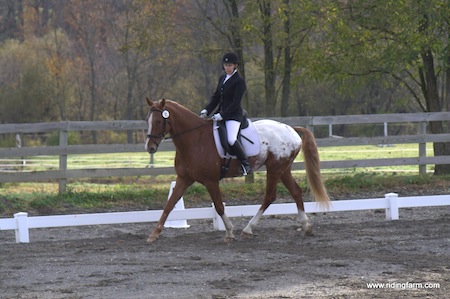Site Menu:
| This is an archived Horseadvice.com Discussion. The parent article and menus are available on the navigation menu below: |
| HorseAdvice.com » Diseases of Horses » Lameness » Diseases of the Spine, Back & Pelvis » Lower Back Pain in Horses » |
| Discussion on Interspinous Ligament Desmotomy... any info? | |
| Author | Message |
| Member: adriaa |
Posted on Sunday, Dec 16, 2012 - 6:28 pm: Hello HA folks,My guy Cris that I chronicled the past 2 years of back issues, training issues in the post: https://www.horseadvice.com/horse/messages/7/406266.html has been diagnosed, via radiograph, with with moderate kissing spine, with significant impingement in T15,T16,T17 and T18, right under the saddle. This pretty much explains a lot. The new vet, who specializes in back issues also agrees with me that he probably had a traumatic event such as flipping over and his SI joint is uneven and funky. he's short backed and I guess kissing spine is common in horses with short backs and possibly even congenital. He's having shockwave therapy and Mesotherapy on Tuesday. I did some research and found something a vet is doing in England which is fairly non-invasive, unlike the traditional surgery which is done, but sounds kind of scary at the same time, cutting the interspinous ligament and releasing the pressure, and allowing the horse to stretch his back. I understand what it's doing but would there be serious long term affects as the horse age?. Just wondering if anyone, DR. O has an opinion on this. I am not sure if anyone is doing it in the states yet. Cris is doing SO much better and he's come a long way due to correct riding and correct saddle fit, but I'd like to alleviate his pains issues once and for all. the vet doesn't think he's in pain all the time but obviously sometimes it really bothers him, also prior to correct saddle fit I'm sure he experienced enough pain to make it a bad memory! I think this is why he liked the western saddle so much, different pressure distribution! thanks all! 
|
| Moderator: DrO |
Posted on Wednesday, Dec 19, 2012 - 10:42 pm: Hello Adria,Vet Surg. 2012 Oct;41(7):890-7. A controlled study evaluating a novel surgical treatment for kissing spines in standing sedated horses. Coomer RP, McKane SA, Smith N, Vandeweerd JM. Source Cotts Equine Hospital, Narberth, United Kingdom. richcoomer@hotmail.com OBJECTIVE: To compare the results of a novel minimally invasive surgical technique with intralesional corticosteroid medication, as treatment for overriding dorsal spinous processes (ORDSP) in horses. STUDY DESIGN: Retrospective controlled clinical case series. ANIMALS: Horses (n = 68) with ORDSP. METHODS: ORDSP was diagnosed based on history, clinical, and radiographic examination. All narrowed spaces were treated. Horses undergoing medical treatment had methylprednisolone acetate injected directly in the affected space under radiographic control. Surgical cases had interspinous ligament desmotomy (ISLD) using Mayo scissors; supraspinous ligaments were left intact. All horses had the same controlled exercise plan and returned to work 3-6 weeks after treatment. RESULTS: Methylprednisolone was administered in 1-7 spaces in 38 cases, compared with ISLD in 3-8 spaces in 37 cases. Thirty-four horses (89%) treated medically initially resolved signs of back compared with 35 horses (95%) treated surgically. From these, back pain recurred in 19 medical cases and in none of the surgical cases. Horses having ISLD were 24 times more likely to experience long-term resolution of signs of back pain (OR 24; 95%CI: 5-115; P = < .0001). Repeat radiographs in 19 surgical cases indicated that interspinous spaces widened significantly postoperatively (P = < .0001). CONCLUSIONS: This surgical technique allowed horses with back pain and radiographic ORDSP to return to work without further clinical signs of back pain and to show radiographic evidence of improvement. DrO |
Horseadvice.com
is The Horseman's Advisor
Helping Thousands of Equestrians, Farriers, and Veterinarians Every Day
All rights reserved, © 1997 -
is The Horseman's Advisor
Helping Thousands of Equestrians, Farriers, and Veterinarians Every Day
All rights reserved, © 1997 -
